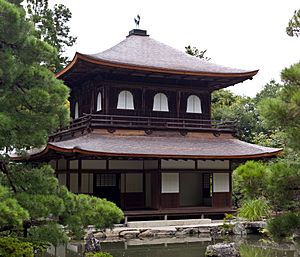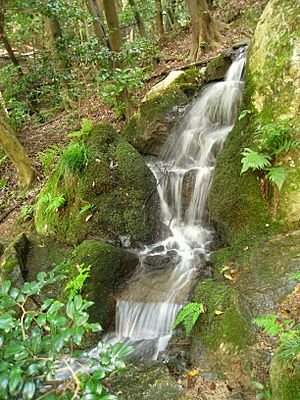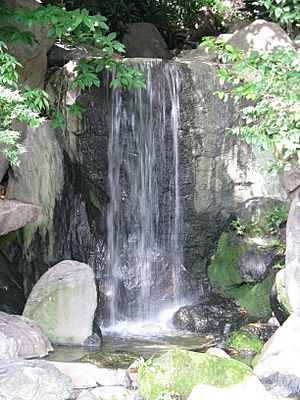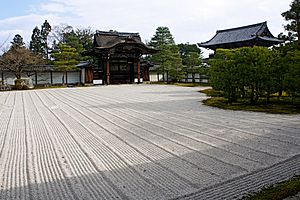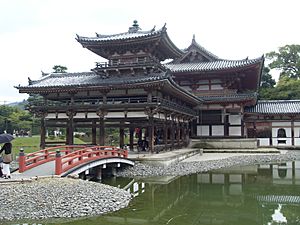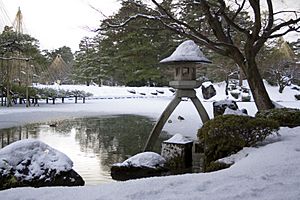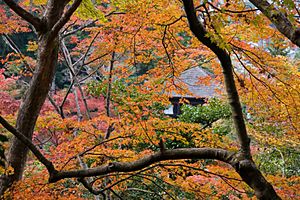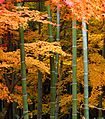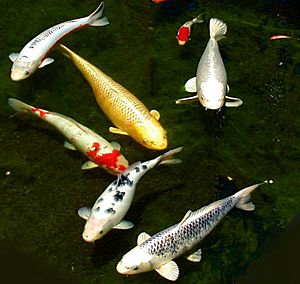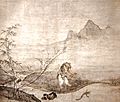Japanese garden facts for kids
A Japanese garden is a special kind of garden from Japan. It's designed to look like a tiny, peaceful landscape. The main idea behind these gardens is to create a feeling of calm and balance.
Contents
The Story of Japanese Gardens
The oldest book about making Japanese gardens is called Sakuteiki. It means "Records of Garden Making." This book was written in the 11th century, but it shares ideas that people had been talking about for a long, long time.
Different Kinds of Gardens
There are several types of Japanese gardens, each made for a different way to enjoy them:
- Thinking Gardens (kanshō): These gardens are made to be looked at and enjoyed from just one spot, like a porch or a special viewing platform. A famous example is the rock and gravel garden at Ryōan-ji in Kyoto.
- Walking Gardens (shūyū): These gardens are designed for you to walk through and discover new views as you go. You explore the garden by following a path. The garden at Ginkaku-ji in Kyoto is a good example.
- Boating Gardens (funasobi): These gardens have a large pond at their center. The best way to see them is from a boat on the pond. The garden at Byōdō-in near Kyoto is a funasobi garden.
- Many-Pleasure Gardens (kaiyū): These gardens combine ideas from the other types. They usually have a central pond and many paths, so you can walk, boat, and find special spots to sit and think. The garden at Katsura Imperial Villa is a great example of this style.
Parts of a Japanese Garden
Water Features
Japanese gardens are special because they capture the feeling of nature. Unlike many Western gardens that focus on colorful flowers, Japanese gardens are designed with spiritual ideas in mind. They often use natural materials to create a space that looks like a beautiful part of nature.
Most Japanese gardens have water, like a pond or a stream. In dry rock gardens, white sand is used to represent water. In Buddhism, water and stone are like yin and yang – two opposites that work together perfectly. A traditional garden usually has a pond with an interesting shape, or sometimes two or more ponds connected by a stream. There might also be a small waterfall, like a tiny version of Japan's famous mountain waterfalls.
In old gardens, ponds and streams were placed very carefully using a practice called geomancy. This is an art and science about placing things to bring good luck. The first Japanese garden book, Sakuteiki, said that water should flow into the garden from the east or southeast and move towards the west. This was because the east was home to the Green Dragon, and the west was home to the White Tiger, both ancient gods. Water flowing this way was believed to carry away bad luck and bring good health and a long life to the garden owner.
Another lucky way for water to flow was from north to south. North represents water, and south represents fire in Buddhist ideas. Since they are opposites, this flow was also thought to bring good fortune.
Traditional Japanese gardens often have small islands in their ponds. In sacred temple gardens, an island might represent Mount Penglai or Mount Hōrai, which are legendary homes of special, immortal beings.
Waterfalls are very important in Japanese gardens. They are miniature versions of the waterfalls found in Japan's mountains. The Sakuteiki book described seven different kinds of waterfalls. It even suggested that a waterfall should face the moon if possible, so its reflection could be seen in the water.
-
Youkoukan Garden in Fukui Prefecture has a miniature beach and mountain.
Rocks and Sand
Rocks, sand, and gravel are key parts of a Japanese garden. A tall, upright rock might represent Mount Horai, or Mount Sumeru from Buddhist teachings, or even a carp jumping out of the water. A flat rock could represent the earth. Sand or gravel can stand for a beach or a flowing river. Rocks and water also symbolize yin and yang (called in and yō in Japanese) in Buddhist ideas. The hard rock and soft water complete each other, and even soft water can wear away hard rock over time.
Rocks are placed very carefully in groups of two, three, five, or seven. Groups of three are the most common. In a group of three, the tallest rock usually stands for heaven, the shortest for earth, and the middle-sized rock for humanity, linking heaven and earth.
Long ago in Japan, sand (suna) and gravel (jari) were used around Shinto shrines and Buddhist temples. Later, they were used in Japanese rock gardens, also known as Zen Buddhist gardens, to represent water or clouds. White sand stood for purity, but sand could also be gray, brown, or bluish-black.
The way stones are placed in Japanese gardens to look like islands (and later mountains) is a beautiful part of their design. Placing rocks is all about showing nature in its most basic form, which is the main goal of all Japanese gardens.
-
Ankokuji garden in Hiroshima has rocks of different, but matching, sizes and colors.
Garden Bridges
Bridges first appeared in Japanese gardens during the Heian period (794-1185). At Byōdō-in garden in Kyoto, a wooden bridge connects the Phoenix pavilion to a small island of stones. This island represents Mount Penglai or Mount Horai, the legendary home of the Eight Immortals in Taoism. The bridge itself symbolized the path to paradise and living forever.
Bridges could be made of stone (ishibashi), wood, or even logs covered with earth and moss (dobashi). They could be arched (soribashi) or flat (hirabashi). Sometimes, if they were part of a temple garden, they were painted red, like in China. But most Japanese garden bridges were left unpainted.
During the Edo period (1603-1868), large walking gardens became popular. These gardens had streams and winding paths with many bridges, usually made of rustic stone or wood. These bridges helped visitors explore all the beautiful views in the garden.
-
A bridge at Tokushima castle made of two stones resting on a third stone (1592).
Stone Lanterns and Water Basins
Japanese stone lanterns have been around since the Nara period (710-794) and the Heian period (794-1185). At first, they were only found at Buddhist temples, lighting the paths. Later, they were also used at Shinto shrines. Over time, they became popular in tea gardens and then in all kinds of gardens just for decoration. A complete stone lantern (dai-doro) represents the five elements of Buddhist ideas.
Stone water basins, called tsukubai, were originally placed in gardens for visitors to wash their hands and mouths before a tea ceremony. Water flows into the basin from a bamboo pipe called a kakei, and there's usually a wooden ladle to scoop the water. In tea gardens, the basin was placed low so people had to bend down to reach the water, showing humility.
-
A stone water basin in Sakamoto, Ōtsu, Shiga.
Trees and Flowers
In a Japanese garden, nothing is left to chance; everything is carefully planned. Each plant is chosen for its beauty. Plants might hide things you don't want to see, create a background for other garden features, or make a scene that looks like a beautiful painting. Trees are often chosen for their amazing autumn colors. Moss is often used to make the garden look very old. Flowers are also picked based on when they bloom. Formal flowerbeds are rare in older gardens but are more common in modern ones. Some plants are chosen for their special meaning, like the lotus, which is sacred in Buddhist teachings, or the pine tree, which represents a long life.
Trees are carefully trimmed to create beautiful views and to make sure they don't block other parts of the garden. Their growth is also controlled using a technique called Niwaki, which gives them artistic shapes and makes them look older. Sometimes, trees are bent to create shadows or better reflections in the water. Very old pine trees are often supported by wooden props or ropes to keep their branches from breaking under the weight of snow.
Some common trees and plants found in Japanese gardens include the azalea (tsutsuji), the camellia (tsubaki), the oak (kashiwa), the Japanese apricot (ume), cherry (sakura), maple (momiji), the willow (yanagi), the ginkgo (ichō), the Japanese cypress (hinoki), the Japanese cedar (sugi), pine (matsu), and bamboo (take).
Fish in Gardens
Using fish, especially koi (colored carp) or goldfish, as a beautiful part of gardens came from Chinese gardens. Goldfish were first developed in China over a thousand years ago. People carefully bred Prussian carp to get different colors. By the Song dynasty (960–1279), goldfish came in yellow, orange, white, and red-and-white. Goldfish were brought to Japan in the 16th century. Koi were developed from common carp in Japan in the 1820s. Koi are just common carp (Cyprinus carpio) that have been chosen for their colors. They are not a different species, and if they breed freely, their colors will go back to normal after a few generations.
Images for kids
-
A Japanese Garden in the Tatton Park Gardens, England.
-
Ise Jingu, a Shinto shrine started in the 7th century, surrounded by white gravel.
-
Byōdō-in: A Jōdo-shiki garden.
-
The naka-niwa or courtyard garden of a former geisha house in Kanazawa, Ishikawa. The trees are covered with straw to protect them from snow.
-
Claude Monet, Bridge over a Pond of Water Lilies, 1899, Metropolitan Museum of Art.
-
A painting of part of Landscape of the Four Seasons by the monk Tenshō Shūbun from the Muromachi period. It shows an ideal Japanese landscape where people lived simply and in harmony with nature. This ideal was also shown in Japanese gardens.
-
Tenryū-ji Garden in Kyoto. (A Kaiyū-shiki Garden, finished in the 14th century).
-
Kōraku-en in Okayama. (A Kaiyū-shiki Garden, finished in the 17th century).
-
Drop of Water Memorial Hall in New Taipei City, Taiwan.
-
This view from the Symbolic Mountain in the gardens in Cowra, Australia shows many typical parts of a Japanese garden.
-
A Japanese zen garden at the Auburn Botanical Gardens, in Auburn, Sydney.
-
Japanese Garden, Tatton Park Gardens.
-
Japanese Garden, Tully, County Kildare. Red arched bridges are more Chinese and rarely seen in Japan, but often in Japanese-style gardens outside Japan.
-
Brooklyn Botanic Garden's Japanese Hill-and-Pond Garden (Brooklyn, New York); designed by Takeo Shiota, it was one of the first gardens in an American botanical garden and reportedly the first free one.
-
The Japanese Garden in Przelewice, Poland.
-
The Japanese Garden in Lankester Botanical Gardens, Costa Rica.
-
Osawa lake in Kyoto was part of the old imperial gardens of the Emperor Saga (809–823).
-
A modern Japanese garden at the Kochi Museum of Art.
-
The balanced and fancy architecture of the Phoenix Hall in Byōdō-in Garden, Kyoto (1052), was inspired by Chinese Song Dynasty architecture.
-
A chashitsu or teahouse in Jo-an garden in Inuyama, from 1618. The simple Zen teahouse style began to be used on all Japanese buildings, from garden pavilions to palaces. This teahouse was named a National Treasure of Japan in 1951.
-
Koi in Himeji Koko-en Garden.
-
Byōdō-in Temple in Uji, near Kyoto.
-
Enjō-ji Temple in Nara Prefecture is a good example of a paradise garden from the late Heian Period.
-
Suizen-ji Jōju-en Garden, started in 1636, has a miniature copy of Mount Fuji. The trees on the upper part of the hill are trimmed to be smaller, to make the mountain look taller.
See also
 In Spanish: Jardín japonés para niños
In Spanish: Jardín japonés para niños


